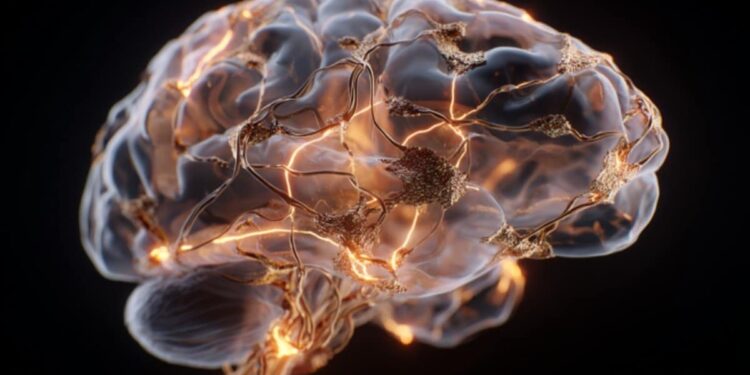Summary: Researchers found that lecanemab, the Alzheimer’s drug designed to eliminate β-amyloid plaques, does not improve the brain’s waste removal system in the short term. In a three-month study using MRI-based DTI-ALPS imaging, scientists observed no measurable recovery in lymphatic function after treatment.
This suggests that once neuronal and elimination system damage occurs, it may be too advanced to be quickly reversed. The results emphasize the need for multi-target strategies to address Alzheimer’s disease beyond mere amyloid reduction.
Key facts
Study finding: Lecanemab reduces β-amyloid but does not restore lymphatic waste clearance after 3 months. Implication: Short-term therapy may not repair neuronal damage established in Alzheimer’s disease. Future Direction: Research will evaluate long-term effects and age-related factors that influence treatment outcomes.
Source: Osaka Metropolitan University
A group at Osaka Metropolitan University in Japan, led by graduate student Tatsushi Oura and Dr. Hiroyuki Tatekawa, found that treatment with the drug lecanemab to remove amyloid plaques in the brain does not change waste removal function in the brains of Alzheimer’s disease (AD) patients in the short term.
This suggests that even after treatment, the nerves of AD patients are already damaged and waste removal function does not recover in the short term. Their findings show the complexity of the disease and the need to address multiple pathways causing it simultaneously in the future.
Their findings add to the complicated process of unraveling the mechanisms of AD. Despite being the most common form of neurodegenerative disease, it is difficult to treat due to its multiple causes.
One cause of nerve damage common in AD is the buildup of the β-amyloid (Aβ) protein in the brain. In healthy patients, the glymphatic system moves cerebrospinal fluid along the spaces around the arteries into the brain tissue, where it mixes with interstitial fluid to remove metabolic wastes such as Aβ. This is called the “glymphatic system” because of the glial cells involved in the process.
However, in AD patients, Aβ builds up, hardening the arteries and reducing flow from the brain to the cerebrospinal fluid. This blockage triggers a chain of neurodegenerative processes that cause AD symptoms.
The recently approved therapeutic lecanemab reduces accumulated Aβ. The team from the university’s School of Medicine evaluated the lymphatic system before and after treatment in patients who received lecanemab therapy, using the DTI-ALPS index.
Contrary to expectations, they found no significant changes in the index between pretreatment and 3 months after treatment.
They concluded that although anti-amyloid therapy may reduce plaque burden and slow further cognitive worsening, it may be insufficient to restore lost function. This suggests that neuronal damage and elimination system deficits are already well established when the patient begins to show symptoms. Their findings show the variety of factors involved in the progression of AD, many of which are not easily reversible.
“Even when lecanemab reduces Aβ, the deterioration of the glymphatic system may not recover in the short term,” Oura said.
“In the future, we want to look at factors such as age, stage of disease, and degree of white matter lesions to better understand the relationship between changes in the lymphatic system due to lecanemab treatment and treatment outcome. This will help understand how best to deliver treatment to patients.”
Funding: This study was supported by the Takeda Science Foundation (ROR ID: 02y123g31) and the Japan Society for the Promotion of Science (JSPS) KAKENHI (grant number: 25K19115). Data were obtained from OASIS (OASIS-3, Longitudinal Multimodal Neuroimaging: Principal Investigators: T. Benzinger, D. Marcus, and J. Morris, supported by NIH Grants: NIH P30 AG066444, P50 AG00561, P30 NS09857781, P01 AG026276, P01 AG003991, R01 AG043434, UL1 TR000448 and R01 EB009352).
Key questions answered:
A: Not immediately. The study found that while lecanemab removes amyloid plaques, it does not restore the brain’s waste-removing lymphatic system in the short term.
A: It suggests that removing amyloid alone is not enough: damage to the nerves and elimination system in Alzheimer’s disease may require multitargeted therapies.
A: Researchers are now exploring how age, stage of disease, and duration of long-term treatment affect lymphatic recovery and overall brain health.
About this research news in neuropharmacology and Alzheimer’s disease
Author: Mateo Coslett
Source: Osaka Metropolitan University
Contact: Matthew Coslett – Osaka Metropolitan University
Image: Image is credited to Neuroscience News.
Original research: Open access.
“Unchanged early diffusion tensor imaging along the perivascular space index after amyloid-targeted disease-modifying therapy in Alzheimer’s disease: a preliminary study” by Hiroyuki Tatekawa et al. Magnetic Resonance Imaging Magazine
Abstract
Unchanged early diffusion tensor imaging along the perivascular space index after amyloid-targeted disease-modifying therapy in Alzheimer’s disease: a preliminary study
Alzheimer’s disease (AD) is characterized by the progressive accumulation of β-amyloid peptides in the brain parenchyma, and impaired clearance of interstitial waste through the glymphatic system is suggested as a contributing factor.
Recently approved disease-modifying (DM) monoclonal antibodies, such as lecanemab, are expected to slow cognitive decline by enhancing β-amyloid clearance. Diffusion tensor imaging index throughout the perivascular space (DTIALPS) has emerged as a noninvasive surrogate marker suggested to be associated with glymphatic activity.
This index decreases with normal aging and is significantly lower in AD patients than in cognitively normal individuals. Although DM therapy (DMT) can affect the DTI-ALPS index, no studies have examined longitudinal changes in the DTI-ALPS index after the onset of DMT.
Therefore, this study quantified the DTI-ALPS index in AD patients before and 3 months after initiation of amyloid-targeted DMT to generate provisional reference values for longitudinal evaluation of future DM-treated cohorts.




















